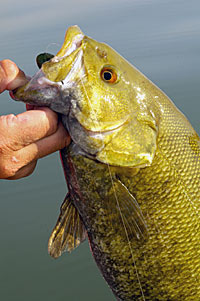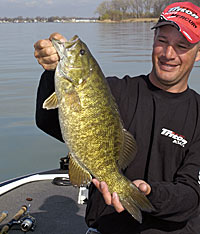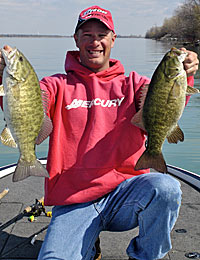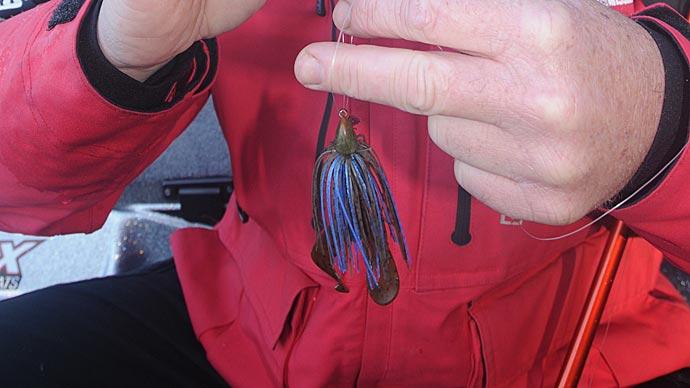
It’s common knowledge that some of the best fishing for trophy Great Lakes smallmouths takes place in late fall and early winter when pods of smallies set up house adjacent to isolated structures in deep water. The bass are highly concentrated, sometimes challenging to locate, and relatively passive, but the rewards are catching bronzebacks that consistently tip the scales from 3-1/2 to 5 pounds. The chance for a real trophy nudging 7 pounds or more is genuine.
The traditional way of targeting these bass is with jigging spoons and blade baits. Still, savvy anglers are discovering that deep drop-shotting is a surefire technique for late-season smallies and has replaced the usual hardware.
“You know deep drop-shotting works all year long,” claimed accomplished smallmouth guide Jerry Gostenik “The method is so effective that it’s replacing the tube jig as the most productive technique for Great Lakes smallmouths. It’s so damn effective because of the vertical presentation, and it just seems to generate more bites and hookups. I use it almost exclusively when targeting late-season bass on Lake Eire, Lake St. Clair, and other places.

“As a guide, it’s a perfect technique because my clients don’t have to feel the bite or cast and work the bait,” Gostenik offered. “I mean, you can set the rod on the side of the boat and catch fish. You don’t have to manipulate the bait. Wave action alone will cause the bait to quiver and bounce; that is exactly what you want. Because the weight is on the bottom and the bait is above it, you have a much better sense of feel. There’s no guessing if you have a bite. Even in icy water, the bass hit it harder than you think. It’s an easy technique to use, it’s easy to hook fish, and it’s the perfect technique for guiding.”
Of course, even the best technique won’t produce if you’re not overfishing. That’s where experience, and GPS, come in. “By late fall or early winter, you’re going to find the bass concentrated where they’re going to spend the winter,” Gostenik said. “They’ll use the same piece of structure year after year. It depends on the water temperature. Once it reaches 43 degrees, they are typically set up in their winter pattern, but if the water temperature is 47 or 48 degrees, they may still be shallow, going on one last feeding binge for the freeze.
“Once in deep water, the bass are not actually on a hump or structure but schooled nearby on an adjacent flat. They relate to the last rock piles and structures before disappearing into the basin. In Lake Erie’s Western Basin, it’s typically in 24 feet of water, but in the Central Basin, it might be deeper. Last year I had one of the most phenomenal days of bass fishing I’ve ever had on December 15.”
Even the most serious bass anglers have their boats put away long before that.
Each pro or guide has subtle nuances regarding deep drop shotting, but they agree that it’s a go-to technique in late fall and winter.

“You know I still use spoons and blade baits on occasion in the fall, but deep dropping is always a candidate,” claimed smallmouth guru Joe Balog. “It’s a great tournament tactic because it produces a tremendous hook-up ratio. Some days you’re only going to get eight or ten bites, and you need to land every one of them if you can.”
“The big thing about deep drop-shotting is the sinker keeps the bait in the zone. It’s a finesse technique that keeps the bait where you put it. That’s important because the strike zone of bass in ultra-cold water is severely reduced. You’re targeting unaggressive bass that will not move far to hit a bait. Less action is often better, and drop-shotting allows you to keep the bait right in their face without much-exaggerated movement, which is usually what they want.”
Because these concentrated pods of smallies are isolated and relatively dormant, finding them and staying on them is half the battle. “My new Minn Kota Ultex trolling motor is a godsend when it comes to deep drop-shotting,” Balog said.
“The new Ultex has a little different heading sensor than the Terrova. The Spot-lock uses GPS with JOG to lock you onto a fishing spot, and they’ve reengineered it to work smarter and hold you stronger and more accurately than ever. The long shaft will hold me in 5-foot waves in an area the size of a card table.” That precision is needed when bass are tightly schooled and tight-lipped.
Having state-of-the-art electronics can help you pinpoint tightly schooled bass and isolated structure. “I couldn’t believe how much I was missing until I started using my Humminbird Helix 10 with side imaging. There are things you see with side imaging that doesn’t look productive with 2D sonar. Finding the last finger of boulders or rocks reaching the main basin is a treasure when you’re deep dropping.”

In many cases, what you put on the drop shot hook is not as important as the technique itself. “I find myself using mainly finesse worms when deep drop-shotting, but in certain locations, you’ll find what I call a converging migration of perch and shad that end up where the smallmouths do in the winter,” Balog said. “When that happens, you want to go to a bigger bait, like a fluke, in colors that imitate perch and shad.”
Jerry Gostenik said he relies basically on one lure when deep drop-shotting. “90% of the time, I’ll have on a Strike King KVD Perfect Plastics Dream Shot in the color they call KVD Magic. The shad/green pumpkin color is about all you need. I use a Mustad Needle Point 2/0 Octopus hook. Using too small a hook can pull out of the fish.” Other hook options include Owner Mosquito Hooks, VMC Spin-Shot Hooks, and Lazer TroKar Drop Shot Hooks.
Other baits worth experimenting with include Poor Boy’s Goby, Berkley’s Gulp 3-inch Fry, PowerBait Power Minnow, and Strike King’s Fat Boy Finesse Worm. Smaller crayfish imitations, like Z-Man’s CrusteaZ, might be enough to coax a dormant, half-frozen smallmouth into snacking.
Leader length when deep drop-shotting is pretty straightforward. “Standard 24-inch range is fine,” said Balog. “There’s no need to change for any reason. You might go to long leaders only in the summer when fish suspend under calm conditions and low oxygen content. Sometimes also in the immediate post-spawn, but not when fishing deep water.”
Sinkers for deep drop-shotting depend on how much you want to spend and sea conditions. “Sinker weight is governed by the depth of water and wave action,” Jerry Gostenik offered. “I typically use a ¼-ounce tungsten weight because you have a better feel. If there are bigger waves, I go to a 3/8 to ½ ounce weight, but that’s only 15 to 20% of the time. I like a teardrop-shaped weight. It seems to get hung up less.” Balog uses standard lead “cherry bomb” weights to offset the risk of losing a bunch of $12 weights throughout a day’s fishing.
Having the right rod will go a long way toward upping your catch when deep drop shotting. “Most manufacturer’s drop-shot rods are too fast and too light,” Balog said. “I prefer a beefier, medium-action, medium-power graphite rod, like a Diawa Steez Fle-X-Lite, 7-foot model. It has more of a parabolic action with a medium taper and medium power.”
Even in most northern climes, the bass season lasts much longer than most people think—time to get the boat back out of storage and grab your snowmobile suit.
BassResource may receive a portion of revenues if you make a purchase using a link above.




